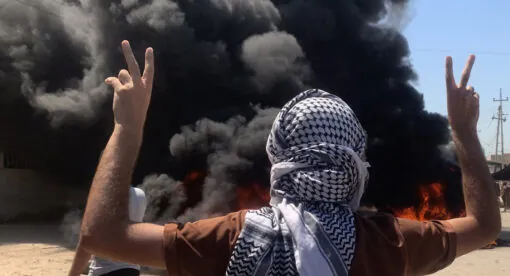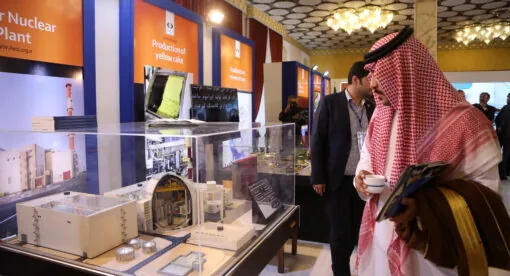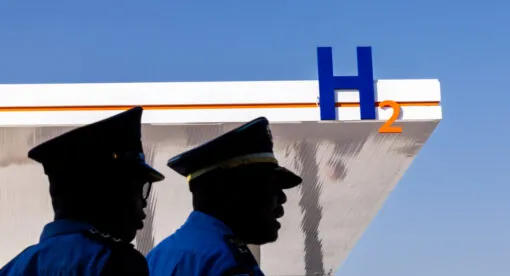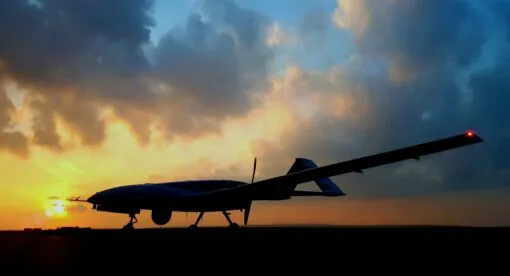In today’s episode of Eurasian Connectivity, host Kamran Bokhari sits down with New Lines’ own Caroline Rose and non-resident fellow Col. Myles Caggins to discuss the recent escalation of events in the Middle East. In addition to recent U.S. strikes on Iranian proxies in Iraq, the trio talks about Iran’s regional goals, Iraqi attitudes toward the Inherent Resolve coalition, and how the U.S. can deal with an increasingly complex future in the region.
Kamran Bokhari:
Hello everyone. Kamran Bokhari here again with another episode of the Eurasian Connectivity Podcast, which is a production of New Lines Institute for Strategy and Policy. Today we are talking about a situation that is emerging, it’s happening as we speak, it’s unfolding. I’m referring to the growing U.S. confrontation with Iran in the Middle East in the wake of the October 7th attack by Hamas that led to the war in Gaza, and we’ve seen the hostilities erupt on the Lebanese-Israeli border hostilities in Syria, in Iraq, and most significantly from Yemen and particularly in the Red Sea area. So that’s what we’re going to be talking about and I have two excellent guests that are going to tell us all about what is happening and what should we expect moving forward. Both of them are actually my colleagues at the New Lines Institute for Strategy and Policy. First off, we have Myles Caggins.
He was a colonel in the U.S. Army and then later on became the founder and CEO of Words Warrior, LLC. It’s a translation, public relations and business advising company. He has offices in New York City and the northern Iraqi city of Erbil in Iraqi Kurdistan. He served as a visiting fellow, a U.S. Army visiting fellow at the Council on Foreign Relations. He served three year-long combat tours in Iraq and most notably, he was the spokesman for the Global Coalition to defeat ISIS in Iraq and Syria.
And with him is my colleague Caroline Rose. She’s the Director of the Strategic Blind Spots portfolio at New Lines. She basically leads research on the intersection of defense security, illicit trades and geopolitical landscapes, stretching from Europe to the Middle East and North Africa. She has two specific projects. One is the project on the capatgon on trade, which I’m sure all of you have heard quite a bit about. And for the purposes of this conversation, she’s also doing a project on post-withdrawal security landscapes. She’s also an adjunct professor at Georgetown University’s Security Studies program in their Edmund Walsh School of Foreign Service. Welcome to you both. Thank you for doing this.
Col. Myles Caggins:
I am so happy to here.
Caroline Rose:
Thanks for having us.
Col. Myles Caggins:
It’s an opportunity to talk about critical issues facing some of our professional partners, friends, and people across the world.
Kamran Bokhari:
Great, so we’ll start off with you, Col. Caggins, and I want to ask you, the 30,000-foot view, let’s start there. How do you see this growing assertiveness or aggressiveness on the part of the Iranians through their proxies making use of the war in Gaza to further their own geostrategic ambitions? What does that do to the U.S. military posture that was kind of winding down because the war against ISIS was successful in the sense that ISIS had been seriously degraded, at least in Syria and Iraq. It still exists in some shape or form, but nothing to the level of what we saw back in the mid-2010s and the late 2010s.
Col. Myles Caggins:
I was in Erbil a few days ago, and the atmosphere among the people in Erbil has changed. Much different than my first visits to Iraq’s Kurdistan region in 2019. And the reason for the change is because of the blatant aggression by Iran and Iranian aligned militias who have conducted more than 170 attacks now in Iraq and Syria, primarily targeted toward U.S. forces, but also ballistic missile strikes that have killed businessmen and civilians inside of Iraq’s Kurdistan region, a region that for two decades since the American invasion to topple Saddam Hussein had seldom been attacked in this manner, certainly not with this frequency and intensity.
So here we are with the U.S. and Iraq entering a series of high-level bilateral discussions to discuss the future of the International Coalition to defeat ISIS. And as a reminder for our listeners, in 2014, the government of Iraq invited the United States and foreign countries in to defeat ISIS as ISIS had swept across Syria and into Iraq and taken the great city of Mosul. Now we’re at a point where there has been back and forth between the United States and Iran and its militia and proxy forces that in recent days has resulted in the United States killing Kataib Hezbollah’s external affairs director and one of their intelligence leaders. And there have been statements between Washington and Baghdad that have been in some ways juxtaposed, but looking for a sliver of continued cooperation as the two nations enter a new type of relationship that I anticipate will continue to have American presence in Iraq and Syria into the foreseeable future.
Kamran Bokhari:
Well, thank you for getting us started. Col. Caggins, a follow-up question to you. This activity on the high seas. We’ve known and we’ve seen Shiite militias in Syria and Iraq do their thing at the behest of Iran, but this is new. The Houthis disrupting commercial shipping in the Red Sea area. And so how is the U.S. military looking at this as a challenge? I know we have ongoing airstrikes and there seems to be some form of cadence now where we’re getting consistent intelligence that is helping us with the targeting of Houthi facilities where they store their ammunition and their weaponry where they have safe houses for operatives and their militiamen. But nonetheless, this seems to be a new challenge. So what’s your take on the maritime space, particularly?
Col. Myles Caggins:
Turning our attention to the Red Sea and the Gulf of Aden, their Houthis have been firing anti-ship missiles and drones at both commercial and military targets. There’s no doubt that these weapons are coming from Iranian factories, Iranian sources, and the United States has cobbled together a confederation of international navies to protect commercial shipping. This is a common practice, and we recognize that maritime security is important for global commerce. I believe more than 15% of all shipping travels along that pathway, and there have already been major shipping companies that are diverting their vessels to take much longer routes around the southern portion of South America and Africa. This is why America has led this group, and frankly, if it were not for the sophisticated technology and the competence of American sailors, there would be multiple civilian shipping vessels that would have been damaged or destroyed by the Houthis.
We have also seen the Houthis take over ships by assaulting them from the sea and they are holding some commercial sailors as hostages. The defense of these shipping lines will continue indefinitely. America recognizes that and the world recognizes that freedom of navigation, the free flow of commerce is essential to international order and the livelihood of people across the world, and I think there will be continued support in Washington for maritime operations to stop Houthis.
From the Houthis perspective, they claim they’re doing this as a result of Israel’s ongoing onslaught of Gaza and their quest to defeat Hamas indefinitely. And so everything, as our listeners know, is interconnected and the shipping is tied to Iran’s actions in Iraq and Syria and Israel’s actions in Gaza. And we are at a time where there is more kinetic, more violence, more direct confrontations with weapon systems in the Middle East than I have observed certainly since 2019 as I’ve watched and worked and lived in the region closely.
Kamran Bokhari:
Caroline, I want to turn to you and I want to take what Col. Caggins just explained, and I want you to frame it within the context of your paradigm that you look through to understand what’s happening strategically in the region, which is the post-withdrawal security landscape. What does this mean strategically for the United States? Col. Caggins talked about the tactical challenges and whatnot, but if we raise altitude here, what are you seeing?
Caroline Rose:
Certainly it’s been quite an interesting and fascinating development what we’ve seen in Northeast Syria and in Iraq with these strikes on U.S. installations and quite a dangerous development as well, as Col. Caggins mentioned. There were three U.S. soldiers that were killed in a recent attack on Tower 22. With this, this has propelled the United States into a very difficult and challenging crossroads. As of now, the United States has played a bit of a numbers game in prolonging their departure from northeast Syria as well as in Iraq, reducing their force contribution, playing with a number of different base transfers, trying to ensure the right amount of forces in northeast Syria and Iraq were enough to compliment capacity building and it advise and assist operations. However, now with such a spike in escalation, and I’ll add a break from precedent, the cases that we saw in 2019 and 2020 with Iran-aligned escalation against U.S. forces, we’ve really started to expand beyond that.
We’ve never seen this pace and scope of Iran-backed milia strikes on U.S. installations and U.S. forces. So with that, the United States is now in a very difficult position where they have to decide whether to increase their force posture considerably or to incrementally withdraw their forces from the region. And we’ve seen, and Col. Caggins mentioned this very briefly, how now the Sudani government in Iraq has now formally initiated discussions. They’re going to have their second phase on February 11th about a coalition timeline for withdrawal, and there is now speculation about the invitation that was extended to U.S. forces in Iraq, whether that will continue and whether U.S. force presence and force posture in Iraq will continue. There are many concerns about if the United States were to withdraw from Iraq in northeast Syria in the first place, but let alone quickly. The last Congressional Quarterly report that was submitted by the Office of Inspector General, they assessed there were many different gaps in capacity and in performance that were identified amongst the Iraqi security forces, the ISF, the Syrian Democratic Forces, the SDF, as well as a number of other partner forces operating alongside U.S. troops in both Iraq and Syria.
Some of them included, for example, deficits in planning, in rotary wing readiness, in internal reform, in collecting intelligence, in logistics and in artillery and some of these key deficits will not only be difficult for these forces to continue carrying out counter-ISIS operations, but importantly upholding rule of law and integrity of their own forces in the wake of an immediate U.S. withdrawal and likelihood that additional distractions might ensue. For example, in northeast Syria, of course you have the constant threat of a Turkish offensive. You also have the encroachment of Iran-aligned militias, the Syrian regime, and then of course in Iraq you have a very difficult balancing act between different forces within the country to try and balance out encroaching Iranian influence as well as Iranian attacks against particular targets. And we’ve been seeing, of course, an uptick in attacks on Kurdish targets in northern Iraq. So this all looking at this big picture, paints a somewhat concerning landscape where a quick withdrawal of U.S. forces might be possible, especially as the threat environment becomes more and more hostile.
Kamran Bokhari:
Thank you, Caroline. So just following up on what you just said, so we know that the ultimate goal of the Iranians is to essentially upend the security architecture. In other words, create a new security architecture for the region and what they’ve been pushing for, and this isn’t new, I remember back in 2011 when U.S. forces were withdrawing after the long occupation following the overthrow of the Saddam regime, the Iranians through their proxies in Iraq, really pushing hard for the United States not to extend their status of forces agreement and it became a controversy at the time.
So how, though this pressure on the United States is working to the advantage of the Iranians and they will continue to push because they have seen the U.S. come and go if you will. I mean the earliest sort of recollection that I have is the Reagan administration withdrawing forces from Lebanon in the wake of the attack on the Marine barracks by Hezbollah. And so that really energized the Iranians and told them that, hey, if you push hard enough, we can force the U.S. to leave and then it’s open season, the coast is clear for whatever they want to do in these parts.
Col. Myles Caggins:
America is making decisions that will always be underpinned by American politics and that’s for good reason. We have elected representatives in America and across America there is a growing anti-intervention sentiment. We have former President Trump who has often talked about removing America from its operations in Syria in particular, but not having America entangled in overseas wars.
There is the political left who is generally anti-war and also a new group in the political right who is using an America-first language to take more of a libertarian view of being non-interventionalist. Iran of course wants to push America out, and not just Iran but Iran, some Iraqi political groups and Turkey and Russia and Syria all want the United States out of Iraq, Syria and the broader Middle East for their own various purposes. I think the discussions that are going to happen with Washington and Baghdad will result in an announcement during Prime Minister Mohammed Shia’Al Sudani’s forthcoming visit to the White House that we anticipate will happen sometime after Ramadan, maybe in the latter part of April or May, and those discussions will probably rename the global coalition to defeat ISIS.
The current mission is called Combined Joint Task Force Operation Inherent Resolve. That mission will probably get a new name, maybe a new patch, but will look the same because Iraq actually does appreciate and value the nearly billion dollars a year in assistance that it receives from the United States and the capabilities and technical advice that the United States and its international partners have provided for Iraqi security forces are what has led to the defeat against ISIS, but also an ongoing overmatch to prevent ISIS from being able to resurge.
Caroline Rose:
Absolutely, I completely agree and I think that when we look at this, the messaging that has come from the Sudani government, we’ve seen similar messaging before and it’s a very clear reflection of the pull that he feels between both the United States, but then also of course the pull from Iran. And this really is I think a step in that balancing act. And when we look at what pressure this puts on the United States itself, and it was mentioned before that there are domestic forces within the United States pushing against the current posture in both Iraq and northeast Syria that is continuing to grow, there are of course a lot of calls against the application of both the 2001 and 2003 authorizations of use of military force. That’s been criticized in how it’s been applied as the United States has launched attacks and proportional responsive attacks on Iran-backed militias.
And I think that over time the United States is going to have to try and identify a way that creates greater flexibility and greater operational capacity with these missions because at the end of the day, they really are there to advise and assist and encourage capacity-building amongst partners that are key for regional security.
When you look at the capacity gaps that are there, there’s so much more work to be done and I think that both the United States and the Iraqi government would be disappointed if the United States just had to up and leave and withdraw that level of operational support that it currently gives. And this of course goes beyond just the sustained defeat of Daesh. This goes of course for just long-term regional security and stability.
Kamran Bokhari:
Col. Caggins, I want to turn to you. I noticed that there was an incident recently in northeastern Syria where Shiite militias struck a facility. I may not have the details accurately, but it seemed like the attack targeted a facility of the SDF and the SDF personnel were either deliberately targeted or got targeted because they got in the crossfire between the militias trying to target U.S. forces. And then we see similar pressure on Iraqi Kurdistan from the Iranians given their own airstrike not too long ago when they struck both in northwestern Syria, northern Iraq, and even in southwestern Pakistan.
So it seems to me, and I’d love to hear from you because you’re very granularly aware of the situation with the Kurds on both sides of that frontier, between Iraq and Syria. What is this doing to our alliance with the Kurds because they find themselves… I mean Caroline just mentioned there’s this balancing act between that Baghdad has to do between Tehran and Washington. What is happening to that balancing act when it comes to a) the Iraqi Kurdistan government up in the north and then b) the SDF, that’s a big partner of the United States?
Col. Myles Caggins:
You asked a good bit of questions there and it nests well with something Carolyn was mentioning about withdrawals. Your listeners should know that the mission of U.S. forces in Syria is totally tied to and dependent on the presence of U.S. forces in Iraq and Iraq’s Kurdistan region in particular. The main logistics hub for food, fuel, water, is coming out of Iraqi Kurdistan and there’s only limited airfields throughout Northeast Syria for resupply.
Now of course, with the capability of the American Air Force and Army, we can sustain forces in far-flung areas for long amounts of time, but that can get very expensive. It’s not efficient. It increases the chance of miscalculations between other regional actors, including Turkey and Russia. So the best way to support American troops in Syria is by having a logistics hub inside of Iraq and Iraqi Kurdistan. The Gen. Mazloum Kobani, who is the leader of the Syrian Democratic Forces, America’s partner in Syria in the fight against ISIS, did an interview this week and he expressed his grave concern about the actions of Iranian-backed militias that have killed his soldiers in Deir el-Zor province and threatened and harmed his soldiers in Hasakah province.
These actions by Iranian backed militias serve in the interest of ISIS. There are still ISIS sleeper cells throughout Syria as well as Iraq, and they have taken some opportunity to maneuver in and conduct assassinations at checkpoints and small-scale attacks while the Syrian Democratic Forces are having to watch their back from all different angles and more groups.
To describe the physical relationship in Syria, America has several base that are really compounds within Syrian Democratic Forces bases. So you’ll have an outer perimeter and typically a small headquarters of SDF and then an inner compound usually with concrete walls and a secondary access area that has the U.S. forces on the inside. The patrols outside the base are typically joint and those are patrols that are designed to be anti-ISIS patrols, presence patrols, and then there’s also interaction with Russian and regime forces. Those interactions are coordinated through a deconfliction cell to prevent any miscalculations and escalations that might occur between Americans and Russians.
The world must remember that there are still 10,000 ISIS fighters detained by Syrian Democratic Forces. And in addition, there are tens of thousands of family members of ISIS, some of whom still maintain the ideology. They are teaching the ISIS ideology to their children and they are conducting criminal and terrorist activities within Al-Hawl Camp and Al-Roj Camp, and they are receiving weapons and money from the outside to continue their terrorist Caliphate mindset activities on the inside of these camps.
Syrian Democratic Forces recently conducted a raid where they found dozens of weapons including pistols, Kalashnikovs, grenades and communication equipment that these women have been using to promote their ideology and coordinate activities throughout the camp and with people on the outside. If America leaves, the SDF is on their own, they will have to make a choice. Do they align with the Syrian regime? Do they try to stand on their own against a onslaught that is likely to come from Turkey and they will have a big question for the world of what to do with these detainees who are still awaiting a final disposition through prosecution or some other means of determining what do we do with 10,000 fighters including 2,000 foreign terrorist fighters who came from more than 50 nations.
Kamran Bokhari:
We’re running short on time here and there’s just so much to talk about, but I want to pose the question to both of you. Col. Caggins, you just mentioned something about if I heard you correctly, if I recall correctly, you said that ISIS benefits from what is happening in terms of the Iranian moves through their proxies and then the American response and the response of American allies in both Iraq and Syria. It seems to me that there the United States seems to be caught in a very long sort of causality loop. We built the new Iraqi regime over a very long period of time at great cost, both human and material during the 2000s and to remove Saddam Hussein from power, that that unleashed ISIS and at the same time it empowered Iran as well.
Now we withdrew and the Iranians took advantage of that strategic vacuum and they began to assert themselves, which provided the opportunity for ISIS to come back. We go in, we’re in this awkward situation where we and Iran and its proxies are both fighting ISIS. We defeat ISIS, and that sort of swings the pendulum back in favor of Iran. Am I hearing you correctly, Col. Caggins? And I’d love to get your thoughts as well, Caroline, that ISIS could stage a comeback given the dominance, given the pendulum swinging in the other direction in a geo-sectarian sense?
Col. Myles Caggins:
I anticipate ISIS cannot make the type of comeback and rise to the prominence it had in 2013 through 2016. Arguably, ISIS is one of the most successful terrorist groups in modern history, being able to take and hold land and establish a proto-state over a few years time. The conditions, the political and social conditions in the Sunni provinces in Iraq though still would make an environment that would be receptive for a small resurgence of ISIS. The presence of Hashid Al Shabi militia groups that were previously not in places like Sinjar and on all the streets of Mosul are an irritant to people in the area. And the people in towns in north and central Iraq are still waiting for money to come from Baghdad central government for reconstruction. They feel oftentimes forgotten about and left behind by the Shia-dominated government in Baghdad and certainly they’re not happy about that situation.
I’d like to make one quick plug related to Syria. I invite listeners to read the report that was prepared by Carolyn Moorman and myself a couple of months ago about potential visa and immigration options for our partner America’s partners in Syria should there be a withdrawal. Because we always must think about what happens next, and I think that’s what you’re talking about, what happens next? What happens? What’s Iran’s next move? What’s ISIS’s next move? What decisions will be made by the federal government of Iraq leadership, and how are all of these different groups intertwined as we’re speaking here in early 2024 where decisions made today can have impacts not only tomorrow but decades down the road?
Kamran Bokhari:
Caroline?
Caroline Rose:
Absolutely. I couldn’t agree more in the sense of as we’re watching all of this unfold rather quickly, especially now that the United States is starting to wind down its proportional response to Iran-backed militias that launched the fatal attack on U.S. Forces at Tower 22. We’re now just seeing reports that the United States has conducted strikes that have killed over 40 personnel affiliated with Iran-backed militias. It’s very likely that we’ll continue to see these strikes and then what’s happening during all of this has been, now these talks about the status of U.S. forces have now been resurged between the United States and Iraq.
So things might happen very quickly, but it’s extremely important for the United States policymakers and its partners to look at the next steps. What a withdrawal would look like, however long or short, how that would impact security partners and starting honest and sometimes difficult conversations about what the United States and its partners should do do to ensure that things are done the most responsibly. And additionally, how to best preserve local security and stability, if withdrawal is inevitable. I also think that there should be a discussion about whether withdrawal should happen at all and how the United States should try and change and evolve and redesign the mission in both the Northeast Syria and Iraq to adequately fit and supplement ongoing advise and assist capacity-building operations.
Kamran Bokhari:
This is such a fascinating topic and I wish we had more time, but we don’t. I just want to give both of you another minute each to offer some concluding thoughts to our listeners in terms of what we should be watching for moving forward, because clearly I don’t think the Iranians are going to back off. It’s a historic opportunity for them that they want to continue to push. They read weakness on the part of the United States, and so they want to be able to push back. That means the United States will continue to be involved. Various other actors are going to be involved and we’re just going to have to watch this over the long haul. But anyway, first, Col. Caggins and then Caroline, you.
Col. Myles Caggins:
In the next few weeks, we’ll see the continuation of this bilateral discussion about the presence of the international coalition to defeat ISIS in Iraq. I think everyone should watch the messaging that comes out of Baghdad closely. You’ll notice even when they’re most irritated about American strikes inside of federal Iraq, they don’t use the language. We want American troops to withdraw immediately. They use this language that says, “We are going to discuss the relationship with the International Coalition.” Those are two distinct things. The Munich Security Forum is coming up here in February, and there will be high-level meetings that will involve the Iraqi prime minister, and we should watch the messaging that comes out of those closely. I think it’s important for all the listeners to recognize that the stakes are very high, that any sort of attack can create a series of counterattacks that can snowball, and ultimately all of this is affecting regular people, regular Iraqis, Syrians, Palestinians, Israelis, Yemenis, and so forth.
And we must keep in mind, even as we are thinking about what to do in the geopolitical play that often so much focuses on military, that really peace should be the goal and we should be looking for some high-level engagement and diplomacy to take all of this down 10 notches and come to a settlement among all groups where we can focus on economic outcomes that benefit all the people in the region.
Kamran Bokhari:
Caroline?
Caroline Rose:
Yes. I think that in terms of spaces to watch over the next few weeks, I think it’ll be extremely important to see what sort of response that Iran-backed militias might launch against U.S. installations and U.S. personnel stationed across the region. Mistakes can often happen. Sometimes a strike that was designed to impose or even craft a message and impose just a few injuries can sometimes, of course, cause fatalities and vice versa. So I think it’ll be extremely important to analyze the strikes that occur after the United States proportional response and see what type of message Iran is trying to fashion to U.S. forces, especially as they’re trying to pressure the Coalition to wind down. I also think it’s extremely important to see the messaging that’s coming out of Iran directly and also what they could additionally do with other proxy forces such as the Houthis and the Red Sea.
Kamran Bokhari:
Thank you so much to both of you for doing this on a Friday afternoon when you both have flights to catch, so I won’t keep you long. Folks, those were Col. Miles Caggins, who is a senior non-resident fellow at the New Lines Institute, and Caroline Rose, who’s the director of the Strategic Blind Spots Portfolio, and we’ve been talking about the strategic picture of what is unfolding as the confrontation with Iran is heating up in the wake of the Gaza War.
There’s a lot that we will need to be able to maintain watch over, but we need to continue to see what’s unfolding. I’ll be back with more in a subsequent and subsequent episodes in the coming weeks and months. For now, this is Kamran Bokhari signing off. Take care out there.








